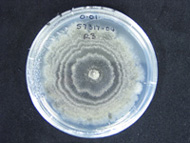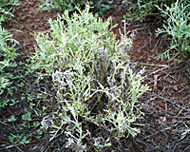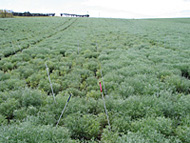Dr. Sarah Pethybridge
University of Tasmania in Australia
My name is Dr. Sarah Pethybridge. I am a plant pathologist at the University of Tasmania in Australia. Tasmania is a small island south of the Australian mainland (approximately 42°S). I work at the Cradle Coast campus on the north-west coast. A feature of the north-western Tasmanian coast is the fertile, volcanic soils, called ‘Krasnozems’, similar to those found in Hawaii. This soil type and the temperate environmental conditions make this area excellent for production of many vegetable and specialty crops. One specialty crop that thrives in Tasmania is pyrethrum. Approximately 2000 hectares (5000 acres) of pyrethrum are grown in Tasmania (Fig. 1), making Tasmania the world’s second largest producer of pyrethrins, following Kenya. A big impact for a small area of the world! Pyrethrum is a perennial plant, which is grown for the production of insecticidal ‘pyrethrins’. These natural insecticides are contained within glands on the flower, which looks like a daisy (Fig. 2). Pyrethrins are used in a variety of organic insecticidal products.
 |
 |
| Figure 1 |
Figure 2 |
I research the diseases that affect pyrethrum. My job description is the equivalent of an “Extension Plant Pathologist” in the United States. But, how did I become a plant pathologist? Well, my first interest in Agricultural Science came from growing up in a small, rural town, where I remember my father’s passionfruit crop being devastated by a disease caused by a virus. I thought this was fascinating, but also experienced first-hand the disappointment of growers witnessing their well-tended crop becoming diseased!
Following high school, I completed an Agricultural Science degree with honours at the University of Tasmania. In the final two years of my degree, I was able to specialize in plant pathology. Afterwards, I continued my interest in plant pathology into a Doctor of Philosophy (Ph.D.) degree at the same University. During this time, I was able to concentrate on one research topic for the entire three and a half years (what fun!) and produce a large book (thesis) on the subject at the end!
I then moved back to the area where I grew up and continued my plant pathological career researching pyrethrum diseases. In this role, I get to work closely with pyrethrum industry personnel, with other researchers in Tasmania and world-wide, assist in mentoring students and providing advice to farmers. Being closely involved with all these people helps with determining the aims of my research and with how I can apply the research results on the producer’s farms. Overall, my research looks to minimize losses caused by plant diseases by recommending effective management strategies.
The major diseases of pyrethrum are caused by plant-pathogenic fungi. Currently, control of these diseases relies on fungicides. One of the most important diseases is called ray blight. It is caused by the fungus Phoma ligulicola (Fig. 3). Phoma causes a variety of symptoms on plants in spring (October in Tasmania) and without fungicides can result in complete crop loss (Fig. 4a and b).

|  |
| Figure 3 |
Figure 4a |
 |
| Figure 4b |
Ray blight became an important problem to pyrethrum production in 2000. By 2002, fungicides were recommended for every pyrethrum crop. However, fungicides are expensive, and these new recommendations caused controversy on how effective they were and whether they were always necessary. To demonstrate the effectiveness of fungicides and calculate the net return to individual growers ($/ha), we initiated small trials in 102 pyrethrum crops of 78 farmers over two years. For comparison, the farmers agreed to leave a small area of their crop untreated by fungicides. One of my job’s most satisfying times involved discussing these results directly with farmers and seeing them become convinced that fungicides worked and being able to give them an estimate of the return from applying them. From these trials, we know those fungicides work in reducing disease severity and significantly increasing the returns to growers.
However, we would like to reduce the number of fungicide applications or the need for fungicides at all. This would make farmers happy, as pesticides are expensive and can damage the environment. Our research is now trying to pinpoint factors involved in disease severity so we can avoid these in the future. For example, we are screening cultivars that may be naturally more resistant to the disease and therefore don’t require as many fungicides. We also know that fields on north-facing slopes and on the top of hills will have lower disease severity because of greater air movement which reduces the time leaves are wet, reducing the need for fungicides. Farmers are therefore encouraged to use fields with these features for pyrethrum production.
Useful Link: To find more about pyrethrum and its products: www.botanicalra.com.au
EXERCISE SUGGESTIONS:
1. Using a map, locate the country, Australia, and the state of Australia, Tasmania.
2. Compare the dates for planting and harvest of crops in Tasmania, Australia, to your area.
3. What other crops are grown in Tasmania?
4. Are any of these the same crops that are grown in your area?
5. How is pyrethrin used?
6. Which country is the world’s largest producer of pyrethrum?
 |
|
Dr. Sarah Pethybridge, Plant Pathologist,
University of Tasmania, Australia.
Read more about Dr. Pethybridge:
http://fcms.its.utas.edu.au/scieng/agsci/pagedetails.asp?lpersonId=153
 |
Views: Phoma causes many diseases in addition to the ray blight of pyrethrum flowers discussed in the article. Phoma terrestris causes a root infection in onion as seen in this figure. Photograph courtesy of D. R. Sumner in Compendium of Onion and Garlic Diseases. Click image for an enlarged view and more information. |
